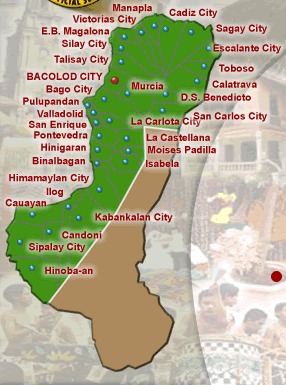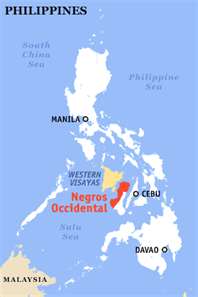
-
МјРЇСІИёСЖШИМі
-
 И№ОЫ КИОЫ Йъ ЗЛЦЎЧЯБт~ ИЎСЖЦЎ ПЙОрБюСі
И№ОЫ КИОЫ Йъ ЗЛЦЎЧЯБт~ ИЎСЖЦЎ ПЙОрБюСі 88,205
88,205 -
 [ЧЪИЎЧЩ ММКЮ] ФЋИ№ХзНК ПЉЧр 100Йш СёБтБт
[ЧЪИЎЧЩ ММКЮ] ФЋИ№ХзНК ПЉЧр 100Йш СёБтБт 38,681
38,681 -
 ИЖДвЖѓ НУГЛ - ИЎРп АјПјСЄКИ. (ЛчСј 16Рх ЦїЧд)
ИЖДвЖѓ НУГЛ - ИЎРп АјПјСЄКИ. (ЛчСј 16Рх ЦїЧд) 30,144
30,144 -
 ММКЮРЧ СіПЊСЄКИ15,141
ММКЮРЧ СіПЊСЄКИ15,141 -
 ИЖДвЖѓ БйБГ - ЕћАЁРЬЕћРЬ ПЉЧр СЄКИ13,668
ИЖДвЖѓ БйБГ - ЕћАЁРЬЕћРЬ ПЉЧр СЄКИ13,668 -
 [ЧЪИЎЧЩ ММКЮ/ИЗХК] ШЃХк МїЙк ПфБн Йз СЄКИ12,676
[ЧЪИЎЧЩ ММКЮ/ИЗХК] ШЃХк МїЙк ПфБн Йз СЄКИ12,676 -
 КИЖѓФЋРЬРЧ И№Еч И№НРРЛ КММі РжДТ ЛчСјУИ.12,556
КИЖѓФЋРЬРЧ И№Еч И№НРРЛ КММі РжДТ ЛчСјУИ.12,556 -
 ИЖДвЖѓ БйБГ - ЦХЛѓЧб ЦјЦї ПЉЧрСЄКИ12,108
ИЖДвЖѓ БйБГ - ЦХЛѓЧб ЦјЦї ПЉЧрСЄКИ12,108 -
 [ММКЮ-ЙшМБТјРх] МБЙкШИЛч РќШЙјШЃПЁПф~11,678
[ММКЮ-ЙшМБТјРх] МБЙкШИЛч РќШЙјШЃПЁПф~11,678 -
 ИЖДвЖѓ СіПЊ(ПЁИЃЙЬХИ -ИЛЖѓХз)РЧ СіЕЕ/ЧбБЙ РННФСЁ/МюЧЮИє11,570
ИЖДвЖѓ СіПЊ(ПЁИЃЙЬХИ -ИЛЖѓХз)РЧ СіЕЕ/ЧбБЙ РННФСЁ/МюЧЮИє11,570


NEGROS OCCIDENTAL
Negros Occidental (Filipino: Kanlurang Negros) is a province of the Philippines located in the Western Visayasregion. Its capital is Bacolod City and it occupies the northwestern half of Negros Island; Negros Oriental is at the southeastern half. Across the Panay Gulf and the Guimaras Strait to the northwest is the island-province of Guimaras and the province of Iloilo on Panay island. Known as the "Sugarbowl of the Philippines", Negros Occidental produces more than half the nation's sugar output.
Culture, arts and people
Negros Occidental has long been a center of culture and arts; the wealth brought about by the sugar industry made sure that the Negrense principalia enjoyed the very best.
Silay City to the north of the capital Bacolod City, nicknamed the "Paris of Negros", is the cultural and artistic center of Western Visayas. It has 30 heritage houses declared by the national historical institute, most notable of which is Balay Negrense; it is also the hometown of National Artist of the Philippines for Architecture Leandro Locsin and international mezzo-soprano Conchita Gaston.
This blossoming in art was due to the economical importance of the area during the Spanish era, Negros became probably the most hispanized area and pro-Spanish area, due to the enormous investments of Spain in the sugar business.
Another famous treasure of Negrense art heritage is to be found in Victorias City, within the confines of the Victorias Milling Company in its chapel is the world famous mural of the Angry Christ, painted by artist Alfonso Ossorio, a scion of the Ossorio family who owned the mill.
The Negrenses' joie de vivre is manifested in the various festivals all over the province, foremost among which are famous MassKara Festival of Bacolod, Pasalamat Festival of La Carlota, Bailes de Luces of La Castellana and Pintaflores Festival of San Carlos. These and other local festivals are featured during the Pana-ad sa Negros Festival staged every April at the 25-hectare tree-lined Panaad Stadium in Bacolod City. Dubbed as the "Festival of Festivals", Pana-ad brings together the 13 cities and 19 towns in a showcase of history, arts and culture, tourism, trade, commerce and industry, beauty and talent as well as games and sports.
Negros Occidental is rich in structures and buildings that are remnants of a once affluent lifestyle. The Palacio Episcopal (1930), San Sebastian Cathedral (1876), and the Capitol Building (1931) are popular landmarks. In most towns, steam locomotives that used to cart sugarcane from the fields to refineries attract steam-engine enthusiasts from all over the world. There are also impressive churches all over the province, both built recently and during the Spanish era.
Demographics
Most residents are of Austronesian heritage. Residents of Negros are called "Negrense". Negros Occidental is predominantly a Hiligaynon-speaking province, because of ties with Iloilo. However, the cities and towns facing the Tañon Strait are Cebuano-speaking due to their proximity to the island-province of Cebu. Tagalog/Filipino and English are widely spoken on both sides of the island.[citation needed]
Negros Occidental is the second-largest province in terms of population after Cebu, with the second largest number of congressional districts.
History
Negros Island was originally known to the natives as "Buglas". When the Spaniards arrived in April 1565, they named it "Negros" because of the dark-skinned natives they found. Two of the earliest native settlements were Binalbagan and Ilog which later became towns in 1572 and 1584, respectively. Other settlements were Hinigaran, Negros Occidental, Bago, Marayo (now Pontevedra), Mamalan (now Himamaylan) and Candaguit (a sitio in San Enrique).
Ilog was made the first capital of the province in 1743. This was later transferred to Himamaylan. Bacolod became the capital in 1849.
The island was divided into Negros Oriental and Negros Occidental in 1890.
On November 5, 1898, a rebellion led by Juan Araneta and Aniceto Lacson began which ended with the defeat of the Spaniards. Following their victory, the revolutionaries formed a Republic of Negros which later included Negros Oriental.
During the succeeding decades between 1901 to the 1930s, Negros Occidental was under American occupation as with the rest of the country. Nonetheless, the economic growth continued especially with Philippine sugar having a part of the US market despite some accompanying socio-economic problems during this period. When the Japanese landed in the province on May 21, 1942, civilian and military leaders in Negros Occidental refused to surrender and instead organized a free government and guerrilla movement under Gov. Alfredo Montelibano Sr. in Negros Island. They helped bring about the surrender of the Japanese forces in Negros in 1945, continued the liberation in Negros Occidental by joint Filipino and American troops together with Negrosanon guerrillas who fought the Japanese forces until the end of World War II.
The history of the province for the post-World War II period has yet to be formally written. Suffice it to briefly note here that this was mainly a period of rehabilitation from destruction of the war. With the sugar industry, the major pillar of the province's economy, as well as other areas being revived, consequent socio-economic growth in the province followed.
The socio-economic life of Negros Occidental from the 1950s up to the 1980s depended as before mainly on the sugar industry. Producing annually about 60% of the country's sugar output, an expansion in the industry with the establishment of several new mills in the late 1960s spurred increased production. A downturn caused by the low world sugar prices in the mid-1970s was followed by possibly the worst sugar prices hitting rock bottom in 1985. The province was also hit by two destructive typhoons in 1984, Nitang and Undang, after a serious drought in 1983.
Negros del Norte was created from Negros Occidental on January 3, 1986. Its creation was declared unconstitutional on July 11, 1986, and was abolished on August 18, 1986.
Towards the end of 1987, the rays of hope started to shine when the over-all economic situation showed a positive upturn. The campaign for agricultural diversification had been gaining momentum, paving the way for more landowners to invest in prawn farming and high-value crops such as fruits, vegetables, livestock and other cash crops.
Investments upswing became apparent by 1988. The participation of the industrial sector accelerated the consumer-led economic growth and development manifested by the increase in sales of consumer goods and by-products.
Today Negros Occidental remains one of the most progressive and largely developed Philippine province, in large due to the profits from the sugar industry but also due to diversification to other fields.
- ЁЄ
- ЁЄ
- ЁЄ
- ЁЄ
- ЁЄ
- ЁЄ
- ЁЄ
- ЁЄ
- ЁЄ
- ЁЄNmjNUuzXqd
- ЁЄNmjNUuzXqd
- ЁЄNmjNUuzXqd
- ЁЄNmjNUuzXqd
- ЁЄNmjNUuzXqd
- ЁЄNmjNUuzXqd














 ЧЪРкДхФФ ОпАЃЛѓДу ПРЧТ
ЧЪРкДхФФ ОпАЃЛѓДу ПРЧТ 11ГтПЌМг МвКёРкИИСЗ 1РЇ
11ГтПЌМг МвКёРкИИСЗ 1РЇ
 ГЛАд ИТДТ ОюЧаПј УЃБт
ГЛАд ИТДТ ОюЧаПј УЃБт
 ИЎОѓ ЧаБГ ЙцЙЎБт
ИЎОѓ ЧаБГ ЙцЙЎБт
 СжИЛПЁ ГЛАЁ ОЕ КёПыРК?
СжИЛПЁ ГЛАЁ ОЕ КёПыРК? УжАэАЁМККё РЬКЅЦЎ СёБтБт
УжАэАЁМККё РЬКЅЦЎ СёБтБт
 ЧіСіПЁМЕЕ ЧЪРкДхФФ!
ЧіСіПЁМЕЕ ЧЪРкДхФФ! ЧіСіПЁМ АЁДЩЧб
ЧіСіПЁМ АЁДЩЧб









 ЧЪРк ЦЏБо Ч§ХУ! ФСНУОюСі МКёНК
ЧЪРк ЦЏБо Ч§ХУ! ФСНУОюСі МКёНК



 АЁСЗПЌМіЗЮ ДйЧдАд ОзЦМКёЦМ
АЁСЗПЌМіЗЮ ДйЧдАд ОзЦМКёЦМ




























